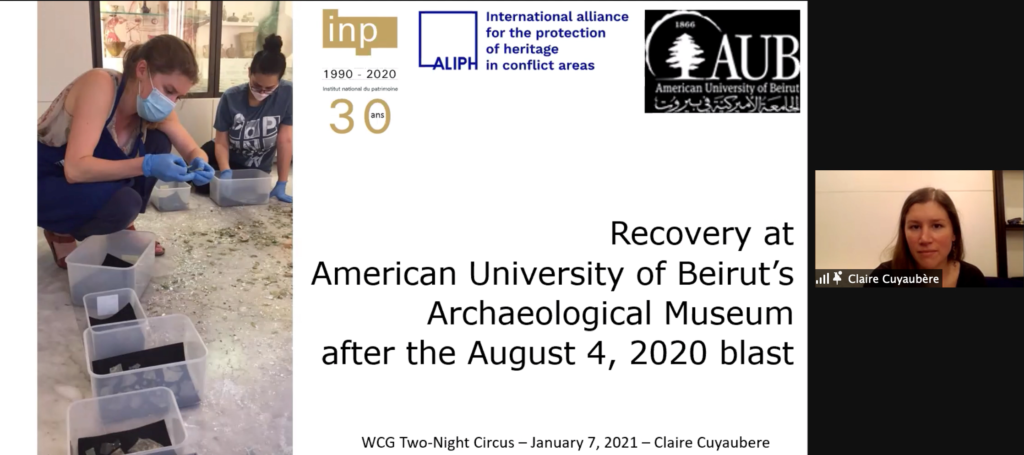Two Night Circus Summary: “Recovery at American University of Beirut’s Archaeological Museum after the August 4, 2020 blast”
Speaker: Claire Cuyaubère
Online Webinar via Zoom
Attendance: 113

Claire Cuyaubère, Objects conservator, started off the first round of the Washington Conservation Guild’s January Two Night Circus discussing her experience with the recovery response at the American University of Beirut’s (AUB) Archeological Museum after the explosive blast at the Port of Beirut on August 4th, 2020. The blast resulted in the death of 200 Beirut residents, thousands with injuries, and many compromised buildings including the AUB Archeological Museum. Although all the windows and doors were blown from the blast, many of the objects went unscathed except for one toppled glass vitrine case, containing a mixture of 74 Phoenician, Roman, and Islamic glass objects.
A joint emergency recovery team was formed between the American University of Beirut, Aliph (International Alliance for the Protection of Heritage in Conflict Areas), and the Institut National du Patrimoine/Ministère de la Culture based in France. The toppled case was left undisturbed until the recovery project began upon Claire’s arrival. Under the supervision of an engineer and the museums’ director, the case was carefully lifted to reveal a mixture of glass from the vitrine and the objects on the floor.
Along with Cuyaubère, a small team of museum staff, research assistants, and student volunteers set up a workspace in the gallery exhibit area. The main concerns of the recovery project were differentiating between the glass from the objects and the vitrine, as well as addressing the condition of the glass sherds of each object. To organize the recovery process, the area on the floor was grided to create “zones”. While wearing nitrile gloves, each “zone” was recovered one at a time into a storage box lined with Plastazote ®. Single object pieces were identified using the museum’s database and stored together. After recovery, the most fragile fragments were consolidated using dilute ParaloidTM B-72.
The recovery project resulted in the organization of all the sherds from the floor, identification of the fragments from 73 out of the 74 objects in the vitrine, and a condition assessment of the sherds with recommendations to prioritize 15 objects for conservation treatment. Objects that were less fragmented were prioritized for treatment. Cuyaubère described the many challenges of this project, including trying to plan without knowing the exact state of the objects under the fallen glass case, the limited resources in Lebanon, and the limited time she could stay. Further work to avoid dust and additional cracking, prioritize future conservation treatments, and identify additional fundraising with international partnerships are in the works.
To find more information about AUB’s fundraiser visit:
https://www.aub.edu.lb/museum_archeo/Pages/AUB-Museum-after-Beirut-blast-on-04-08-2020.aspx
WCG MEETING SUMMARY
By: Anita Dey, Graduate Paper Intern at the Smithsonian Museum of Asian Art, Third Year Graduate Student at the Buffalo State Garman Art Conservation Department.